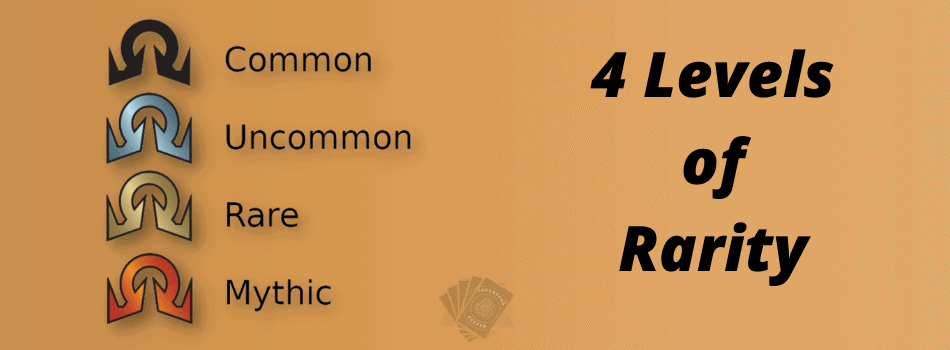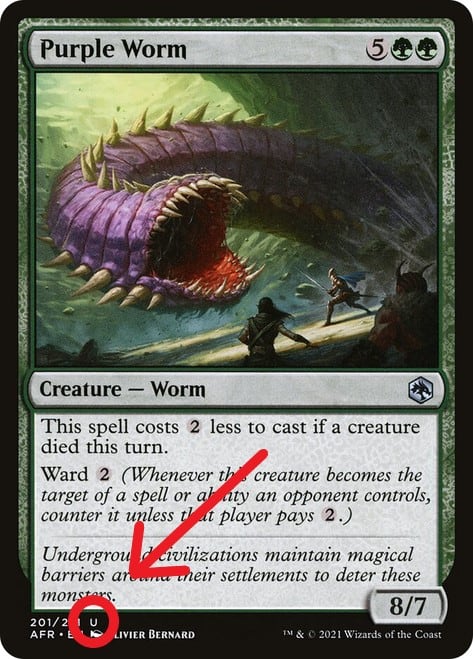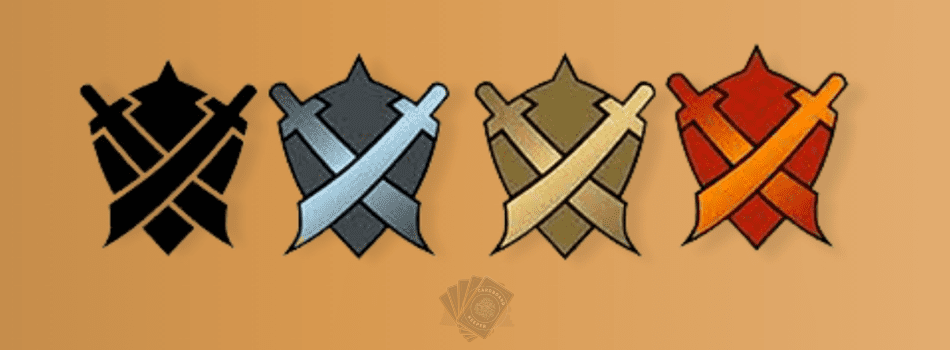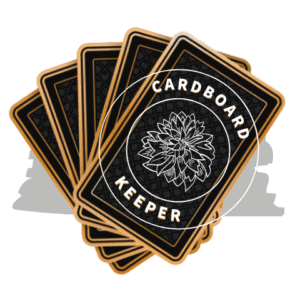Nothing beats the excitement of opening a new pack of Magic cards and discovering what’s inside. There are always plenty of simple, common cards and a few more complex plays as well. If you’re lucky, you might find a rare and extremely powerful card in your pack.
A card’s rarity refers to how often it is included in card booster packs and is usually also associated with the complexity and play potential of the card. There is a ranking system of four different rarity levels that each have an associated color, in addition to special rarities.
Typically, the best decks will have a selection of cards from each rarity category to create a well-rounded and successful playstyle. This beginner’s guide will help you understand what the different rarities mean, and how to identify them.

What are the Levels of Rarity in MTG?
There are four levels of rarity in MTG. In order of increasing rarity, the categories are common, uncommon, rare, and mythic rare. This same ranking is directly associated with how often you will see that type of card.
It is easy to get plenty of common cards, which is good since they are going to act as basic building blocks for your deck. Common cards are easy to understand and play with and will likely be very versatile. While not as exciting as a rare or mythic card, they hold an important place in Magic games.
As you might expect, uncommon cards are going to show up less in card packs. Typically, you will get three uncommon cards in each pack you open. These cards are going to be more complex and more exciting than the common ones.
Uncommon cards are the second level of rarity, so they will not be dramatic game-changers. However, when used to their full potential, they can direct the rest of your deck and heavily influence the strategy you choose to take.
Rare cards will either be very complex or very powerful. you won’t be able to collect very many rare cards by opening packs, but you also won’t need to play with very many rare cards at a time. These cards can quickly dominate a deck and change the course of a game.
Many rare cards have extensive descriptions and conditions that facilitate complicated plays. However, some rare cards are not complex at all but are straightforward powerful plays designed to change the game.
The rarest cards are called mythic rares. These are not included in every pack, but will occasionally replace a rare. These are extremely valuable cards and will be even more influential to gameplay than a rare. They are hard to come by, and you should take very good care of any that you find.
While many strong decks use predominately common or uncommon cards, most of the strongest decks in any given format use at least twelve rares and/or mythics, if not more. Especially in non-rotating formats like Modern, it isn’t strange to see a deck run up to forty rare or mythic rare cards.
How Do You Tell the Rarity of a Magic Card?
There are multiple different ways to tell the rarity of any given MTG card. Probably the easiest way to determine the rarity of a card is to check the color of the expansion symbol.
On the far right of the text bar underneath the illustration, each card will have a symbol that indicates which expansion it belongs to (starting with the sixth edition in 1999). This symbol will be printed in a different color depending on its rarity ranking. the colors black or white, silver, gold, and bronze each indicate a different level of rarity.
You can also tell the rarity of a card by checking the small text on the bottom of the card, just above the border. In the fine print, you should be able to find a collector’s number. This usually includes two, three number digits separated by a backslash.

To the right of the collector’s number, you will find a single letter. This letter is another indicator of the card’s rarity. C, U, R, and M indicate the four levels of rarity. You might also see the letters S, T, or L. These indicate special cards, tokens, and basic lands. These are often considered to be common cards as well.
If you are still struggling to figure out how rare a card is, you can always look it up using the official Magic: The Gathering card database system or Scryfall. Look up the card in question using the MTG system and it will pull up a page full of all the information you could ever want about the card, including its rarity.

MTG rarity colors
Beginning with the Exodus set, the symbol color is the easiest and most common identifier of rarity.
Memorizing the code of which color is which rarity is easy and will help you master the cards. A common card will have the expansion symbol in either black or white. There is no meaningful difference between a black or a white symbol, they both mean the same thing.
Silver is used to indicate uncommon cards, a gold color identifies a rare card, and the official color for a mythic rare is bronze. The cards do not have metallic print, so the “silver” is actually gray and the “gold” is more of a yellow. The “bronze” stays distinct from the gold since it is more of a red-orange color.
A purple symbol is extremely uncommon since it is only possible in the Time Spiral expansion, but purple indicates a special rarity that doesn’t fit any of the four traditional categories.
MTG rarity chart
| Rarity | Frequency in a booster pack | Color | Code Letter |
| Common | 11 (including 1 basic land) | Black or white | C |
| Uncommon | 3 | Silver/gray | U |
| Rare | 1 | Gold/yellow | R |
| Mythic rare | 1/8 chance to replace a rare | Bronze/orange | M |
How Do You Identify Rare MTG Cards?
If you are doing a quick scan of cards to find the rare ones, the easiest way to identify them is will the symbol color. On the text bar underneath the illustration, there will be an expansion symbol on the far right that tells you what set the card belongs to.
Check the symbols for a gold color to quickly identify which cards are rare. You should also be looking out for the bronze color that indicates a mythic rare.
You could also use the collector’s code or search on the MTG card database to identify a rare card.
What is the Rarity Distribution in a Magic Set?
Each year, MTG releases one large stand-alone set and two smaller expansion sets. The exact distribution of card rarity within those sets stays fairly consistent, with one change that started in 2003. There have been exceptions to the pattern for special releases, but this is the typical breakdown.
Before 2003, Mirage through Scourge saw a 350 card set and two, 143 card sets. The 350 card sets have 110 each of common, uncommon, and rare with 20 basic land cards. Smaller sets typically had 55 common, 44 uncommon, and 44 rare cards.
In 2003, the game company announced a change where they wanted to shrink the size of the stand-alone sets and expand the size of the smaller expansions. The big sets have 306 cards, still with 110 commons and 20 basic lands, but only 88 uncommon and 88 rare. The two smaller sets have 165 cards each, with 55 common, 55 uncommon, and 55 rare.
The booster packs of cards are much smaller and have a different ratio of rarity. The regular booster pack you can buy today will have 16 cards, 1 being a marketing card or token and the other fifteen are actual playing cards.
The vast majority of the pack is common in a much higher ratio than the full sets. Each pack has 1 basic land card, 10 common cards, 3 uncommon cards, and 1 rare or mythic card. Most booster packs have a 1/8 chance of including a mythic card in place of the rare.
What Does Special Rarity Mean on an MTG Card?
A purple expansion symbol or an S next to the collector’s code indicates a “special” rarity. These cards are not seen or used very often, and they don’t fit into the regular four-tiered scaling of rarity.
Time Spiral and Unhinged are the only sets that have a special rarity. The timeshifted cards from Time Spiral are so unique that they received the marking “S” when the set was released to indicate how unusual they are.
What are Foil Cards?
Foil cards are alternate versions of regular cards that have a special glossy foil under printed and added to the front.
They are considered “premium” cards because they look nicer and are of higher quality, but they function the same way in a game that the original print would.
Foil prints are considered rare because most cards do not have glossy foil, but this rarity has nothing to do with the rarity ranking of the playing cards.
Foil cards are rare because fewer of them exist, not because of the actual content of the card. That being said, a foil common card is way less rare than a foil mythic. A foil is an even more rare version of whatever rarity the card originally was. The foil version of a card is worth more money and might be more exciting to play with because of how special it is, but holds no value in the actual rules of the game.
How Rare is a Foil Mythic?
A foil mythic card is extremely rare.
Mythics appear in roughly 1 out of every 8 booster packs. One foil card appears in roughly every 6 booster packs. For these two statistics to line up with a foil mythic, you have to be extremely lucky.
Some people claim that a foil mythic will appear once every 216 packs. That is the statistic for getting just any foil mythic possible from a set. If you want a specific mythic rare in foil, your chances are very slim.
You have a higher chance of getting foil mythic cards in pre-release kits, which come with an extra promotional card that is usually chosen at random from a list of the rares and mythics in the set. This increases your odds of getting a foil mythic card to about 1 in 8.
What is the Rarest MTG Card?
All mythic rare cards are equally the rarest in gameplay.
If you are defining rare by how few of the card exists and how difficult it is to find, the rarest cards are the oldest cards. When you are collecting cards, you will have a lot of trouble and spend a lot of money to get the vintage cards from the original magic set.
Black Lotus is the rarest MTG card that can be played with, an artifact that allows you to add three mana of any one color to your pool. It is part of a group of cards called the power nine. These nine cards were part of the original Alpha, Beta, and Unlimited sets that were released the first year of the game. They were the highest-ranking rarity from those first sets. All of the power nine are extremely rare and expensive, but the Black Lotus is the most expensive of them all.
If you are interested in finding out more about Black Lotus and what makes it so far, check out my guide on Why is Black Lotus so Expensive.
The rarest MTG card ever printed is the 1996 World Champion. There is only one copy in existence, which was given to Tom Chanpheng, the winner of the 1996 Championship. All of its printing plates were destroyed, so the card can never be printed again. It now resides with a private collector.
When Did Magic Introduce Mythic Rares?
In 2008, Magic The Gathering announced the addition of mythic rares starting with Shards of Alara.
The game makers noticed that the ranking of “rare” was covering a huge range of rarity in their cards. Adding mythic rare allowed for greater distinction between the power and complexity of cards.
That changed the distribution of rarity within sets. The large sets now have 101 common cards, 60 uncommon, 53 rares, and 15 mythic rares. The smaller sets have 60 common, 40 uncommon, 35 rare, and 10 mythic rare cards. The huge contrast in quantity between mythic rares and the rest of the types effectively elevated the status of certain cards and created a lot of new excitement around ranking.
How Many Mythic Rares are Allowed in a Deck?
The deck you build will depend on which format of MTG you are playing. If you are playing a standard game, there is technically no restriction on how many mythic rares, or cards of any rarity, you can include in your deck.
However, the rule that you cannot have more than four copies of the same card still applies. While you could load up your deck with rares and mythic rares, be careful to maintain a good balance of cards. The common and uncommon cards are still a very important part of a well-functioning deck.
